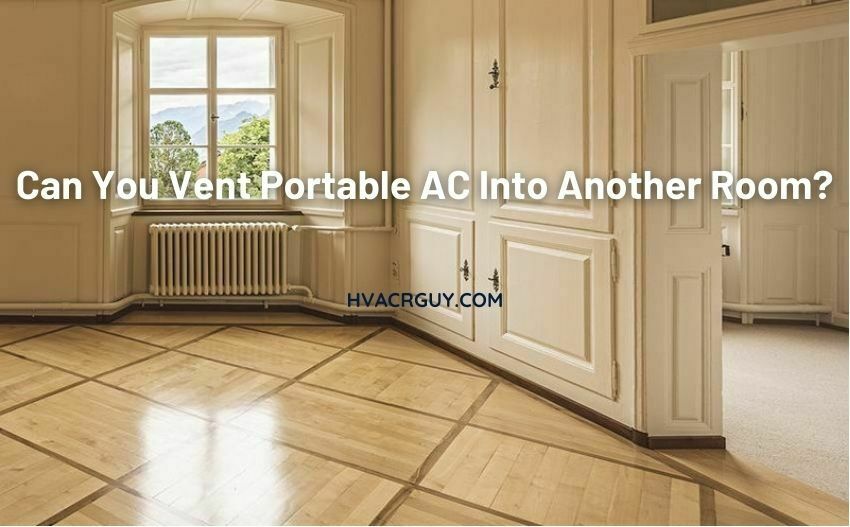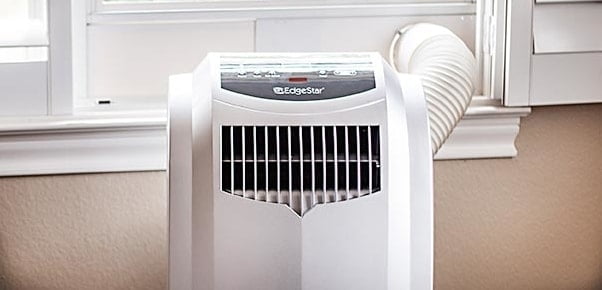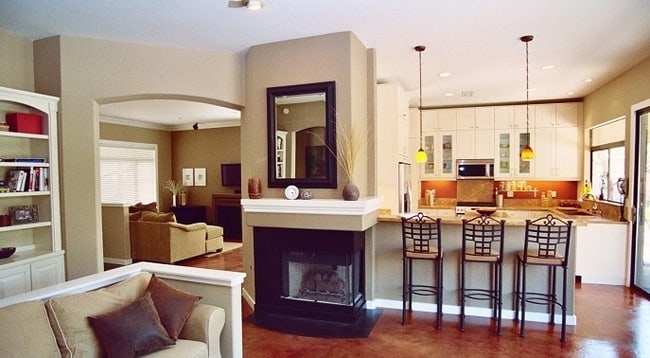Last Updated on January 1, 2024
Usually, one would go for a portable air conditioner for reasons like mobility or no window accessibility. Some may use it due to strict apartment and community rules regarding window AC.
But what to do if you don’t even have a window in your room? Could you possibly vent your portable AC into another room? How about an adjacent room? Well, this article covers that in detail.
Your portable AC will still cool if you vent it into another room of your home, but this is not recommended, as it will increase overall temperature of your home. Consequently, due to heat leaks and high-temperature gradient, AC will consume more power and have lower efficiency.
Also, if your AC is self-evaporative, it will expel moisture in the same room you’re venting in, leading to mold and mildew.
There are various configurations of rooms one may have in a home. Sometimes it may be a good idea to take advantage of heat from the vent. However, it is better to know what is at stake and whether it is worth it.

Why It Is Necessary to Vent Your Portable AC?
Portable air conditioners like most available air conditioners operate on a vapor compression cycle. They use the process of compression, condensation, expansion, and evaporation to reject heat from the refrigerant to outdoors.
During the operation, heat is extracted from the space to be cooled and delivered to the external environment. As a result, the temperature of the room is reduced.
What Happens If You Don’t Vent Your Portable AC?
Think about what will happen if you do not vent your portable air conditioner.
If you don’t vent your portable AC and keep its exhaust in the same room you plan to cool, heat that was supposed to be rejected outside will be rejected in the room. This causes the heat to cycle in the same room. In short, your portable AC is doing nothing at the expense of the energy it is consuming.
Electricity is wasted in taking the heat by refrigeration cycle and giving it in the same room. In fact, in reality, this would cause the room to further heat up.
The only thing a portable AC does when venting in the same room is dehumidification. But this is true only if you are not using a portable AC with self-evaporative technology.
However, most of the portable ACs in the market are either partially or fully evaporative. So, for most portable ACs humidity will be rejected in the same room that is being cooled with no dehumidification, if you decide not to vent them.
4 Drawbacks of Venting Portable AC In a Room of Your Home?
It is practical to vent a portable AC into a different room in your house. This is doable because it fulfills the basic requirement of using an AC i.e., heat is not rejected in the same space that you are targeting to cool.
Well, if it’s OK and doable then what seems to be a problem?
1. Your Portable AC Cooling Effectiveness Will Reduce
The major limitation due to which this is not recommended is the inefficiency of the process. When you vent your portable AC in another room of your house, it is still in the house. So the overall temperature of your home increases.
Let me share with you why that happens in detail and the relevant factors when you vent portable AC indoors.
How Heat Leaks During Normal AC Operation? (Scenario # 1)
Even when you vent a portable AC normally, like by a window, or one of these ways, there is so much restriction to the process. This is because when you cool a single room of your home, it becomes the coolest spot.
Resultantly, a thermal imbalance is created within your home too. Heat tends to rush through other sectors of your home due to a difference of temperature caused by cooling a single room.
In short, even when you cool a room normally with an AC, heat leaks by conduction through the walls. There are minute air gaps present in the room even if it is pretty insulated, i.e., surroundings of windows, under the door etc.
What Changes When Venting into a Room Instead of Outdoors? (Scenario # 2)
Now compare the above situation with when your portable AC rejects heat in an adjoining room or any other room of your house. The temperature gradient in the house would be even bigger and thermal instability will be higher.
By the way, the heat transfer rate is directly proportional to the temperature difference between parts of your home. This means the hotter the adjoining room the more heat will rush in, and the efficiency of your portable AC will reduce. It will also have to work harder to bring the required cooling.
In short, venting into an adjoining room will cause more heat to leak into the room you are cooling. Consequently, there will be less cooling, more power consumption, and more time required to cool your room.
2. Your Portable AC Will Have Lower EER
EER (Energy efficiency ratio) is the ratio of the cooling capacity of your portable AC to its power input. In other words, it is the measure of an air conditioner’s efficiency.
EER, or simply put your portable AC efficiency, reduces as the outdoor temperature increases, or in this case temperature of the room in which you are exhausting the hot air of your unit.
In fact, a study conducted shows that in a typical R410a AC, 20°F increase in outdoor ambient temperature resulted in a 25% rise in compressor power consumption, a more than 13% decrease in total capacity, and finally a 28% decline in EER. These results can be interpolated for any air conditioner as the operation is based on a basic refrigeration cycle.
This means venting into another room of the home will reduce your portable AC’s cooling capacity, reduce its efficiency and increase its power consumption.

3. Lower Performance of Single as Well As Dual-Hose Portable ACs
This reduction in EER, or simply put AC efficiency, is true for both types of portable AC’s, Single Hose and Dual Hose, when you vent them to a room.
Single-hose portable ACs have a phenomenon called negative pressure. They intake air from the internal environment i.e., from within the room. This will create a suction of heat from other parts of the home. Consequently, more heat will leak from other rooms.
This means if you are venting into another room by a single-hose portable AC, especially in an adjoining room, more heat will leak into the room you are cooling. Resultantly, the cooling efficiency and effectiveness of your portable AC will further reduce.
In a dual-hose portable AC, performance would be even lower with this configuration, as air from the hottest room in the home is used to cool its condenser.
By the way, normally, dual-hose portable ACs have higher efficiency compared to single hose ones.
4. Venting in a Room May Cause Mold and Mildew
Despite cooling, an air conditioner also removes humidity from the living space. Humidity is extracted from the atmosphere and collected in a condensate pan.
So even if you are venting in another room, despite the inefficiencies, humidity is still reduced from the cooling space.
However, most portable ACs in the market have self-evaporating technology. This means they automatically expel humidity from the cooling space via exhaust vent hose. Consequently, this will increase humidity in the room where you are venting hot air.
High heat, humidity and food sources (organic material) create an ideal environment for mold and mildew to sustain and grow. Warm and humid conditions in the room where hot humid air is vented by your portable AC may be a good location for that.
How to Vent Your Portable AC Outdoors Without a Window?

If you do not have a window in your room, go for the next best venting option. Window in not a necessity for using portable AC. The real goal to just reject hot air outside.
There are various ways you can vent without a window. I would go with the one that is easiest and requires least modification in the room.
1. Venting Through a Sliding Door
If you have a sliding door in your room, it could work for the vent of your portable AC. A few problems may not let you able choose this option of venting.
- Your sliding door is not opening to the entrance, exit, balcony, etc. to release hot air directly to the external environment. Rather the door is opening in the middle of the home. In this case, this option might not be a good idea.
- Short length of vent hose of your portable AC. Normally portable ACs have vent hoses 5-7 feet long. It is recommended to keep the vent hose’s length less than 12 feet. It is desirable to keep it the same that is selected by the manufacturer.
To be able to reach your sliding door, you will have to alter the length of your portable AC, I advise against it.
2. Venting Through Ceiling
If you have drop ceiling in your room that is usually common in comparatively old constructions, then you may use that to your advantage.
You can use a single tile to attach your vent hose with it. However, you might want to consider a hose that is designed for the purpose (ceiling venting kit). The reason is that normal exhaust hoses are heavy and unsuitable for this purpose.
3. Venting Through Wall
If everything else mentioned doesn’t work for you then you may vent through the wall. It is not as easy as other options. So it is better that you hire a professional to do it. Before using this method, decide how much time you use portable AC in a day and if it is worth it or not.
The hole in the wall will be permanent. Thereby, if you use portable AC for only a small interval of the day try to make the previous options work for you.


